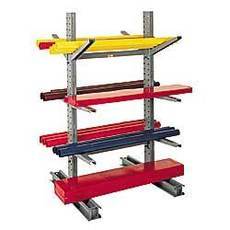top of page
Cantilever Rack
Cantilever Rack Systems & Cantilever Racks
Cantilever rack systems from top manufacturers such as Jarke, Meco, Jaken, Hannibal, Cogan, Steel King, Bluff, Bull Dog, Spectrum and Modern Equipment.
Cantilever racks are the perfect solution for storing sheet and bar stock, furniture and pipe. It is suited to industrial environments, and is frequently seen in outdoor storage yards, with lumber, sheet steel and pipes are stored.
Cantilever Rack Components include the following:
- Starter- A complete, stand alone cantilever rack system consisting of 2 upright columns, a minimum of 2 arms, and one brace set for spacing.
- Add-On - An additional part of a cantilever rack consisting of only 1 upright column, a minimum of 1 arm and a brace set for spacing.
- Single-Sided - Cantilever rack with arms for storage on one side. Typically Single sided units are against the wall.
- Double-Sided Cantilever rack - Cantilever rack with arms for storage on both sides.
- Double-Sided Upright Column - when selecting cantilever rack, one must select either double sided uprights, which have a base that goes in both directions, allowing storage on both sides or
- Single-Sided Upright Columns that have a base in one direction only, allowing storage arms on one side only.
- Brace Sets - Used to create even, consistent spacing between upright columns. Can be as simple as a single bar on a short cantilever rack.
- Arms - This is what holds your materials. Cantilever arms can be either straight, ideal for lumber storage or sheet steel, or inclined to prevent rolling, perfect for pipe storage or lumber storage.
- Lip - on the end of cantilever arms, the lip is an optional piece on the end of cantilever arms that prevents rolling.
- Base - The base of a cantilever upright column. It serves two purposes; First, it is the bottom beam that supports the upright and second, it is the bottom storage level of your cantilever.
Cantilever Rack Selection Guide
Cantilever racks are ideal for storing long, rigid materials such as lumber, pipe, and bar stock. The racks can be front-loaded by hand or with a fork truck or can be used as side pick racks in space-conscious areas. This guide will help you through the ordering process by providing basic information needed to select cantilever rack.
How To Select your Cantilever Rack System
A cantilever rack is configured per bay and consists of three general components: arms, columns, and brace sets.
1. Determine storage needs by taking into account the length, depth, height and weight of the product being stored.
2. Arms: Choose arm style and length, along with the capacity needed to support the load. Two arms (one on each side) create a “level”. Divide the weight of the load per level by two (for one bay) to give the individual arm capacity needed. (This assumes that the load is supported sufficiently by two arms to prevent load deflection).
3. Columns: Determine the number of arms needed per column side and vertical space required. Adding up all of the individual arm capacities and vertical space required will determine the height and combined weight capacity needed for the two columns.
4. Brace: Determine brace set width. Take into account the length of the pieces planned to be stored. Brace set widths will provide center-to-center measurements of the arms installed on columns. One brace set per bay is required.
Example:
1. Product to store: Pipes bundled at 8' long, 10" deep, weighing 2,000 lbs.
2. Arm choice: 12"L, straight, with lip. Load weight is 2,000 lbs. Divide weight by two (one level) to obtain 1,000 lbs. per arm requirement.
3. Column choice: Assuming four levels of load are required, then eight arms would be needed with vertical spacing of 18" apart. Eight arms x 1,000 lbs. capacity per arm = 8,000 lbs. Combined required column capacity (4,000 lbs. per column, single sided) at 8' high would be needed.
4. Brace: 8'L load with two-arm (one bay) support would require a 4' wide brace set.
bottom of page













